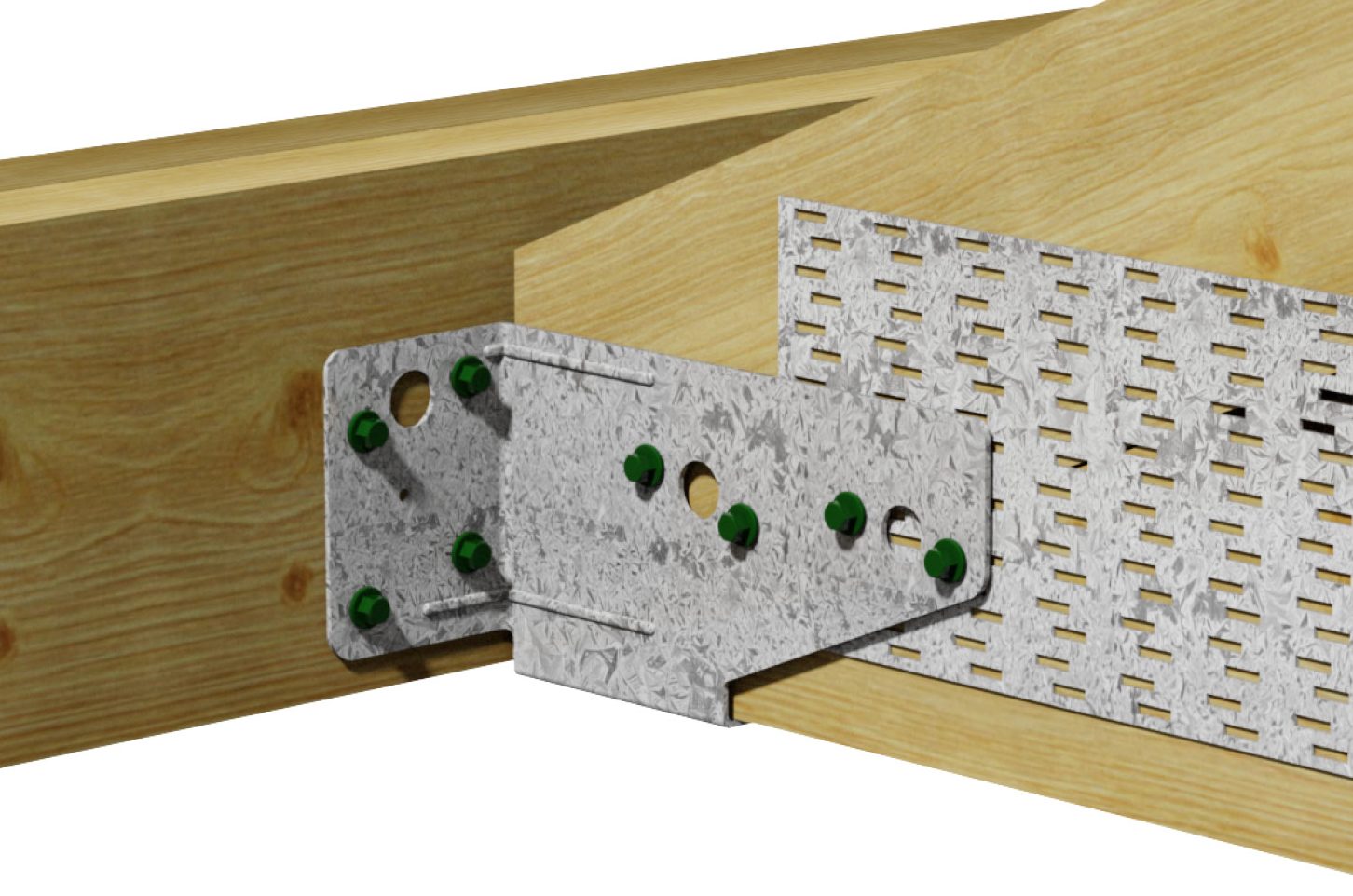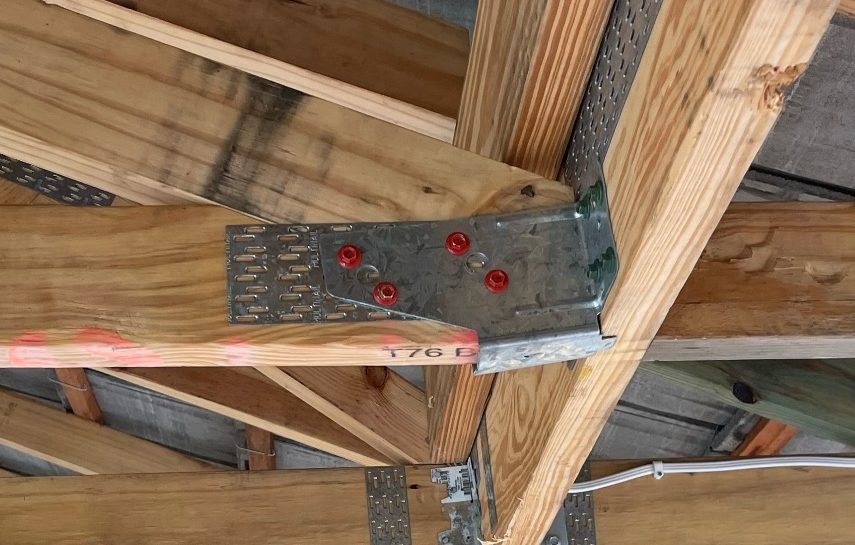News
Girder-Supported Trusses

Rotational restraint in girder-supported trusses
A Girder truss is one that is designed to be stronger than a standard truss in order to support other trusses and beams in a roof. When utilising a girder truss to support standard trusses perpendicular to it, the connection between the two must accomplish 3 things:
- Support the Load.
- Ensure Girder bottom chord cannot be separated from standard trusses.
- Prevent rotational forces from being applied to the standard truss.
Methods of rotation restraint
Prior to the availability of a wide variety of anti-twist and high-load girder bracket products, it was common practice in the construction industry to apply a standard connection detail between girders and standard trusses specified in AS4440 (see figure 1 below).

Figure 1. standard truss boot with anti-twist bracing
In conjunction with the girder bracket, this detail involves the installation of a tension strap nailed to the underside of the girder and supported truss. Whilst the bracket provides the appropriate fixing and transfer of reaction forces, the tensioned strap aims at preventing rotational forces in the standard truss.
With the progressive development of girder bracket products, the use of this method has become decreasingly common. The need for anti-twist bracing straps has diminished with the increased popularity of products advertised by manufacturers as providing rotational restraint to the supported truss. The preference for these products over the traditional method can be attributed to their simpler and quicker installation and their ability to accomplish all three requirements of girder-to-standard truss connections.
On-site issues
Recently, issues have been arising on site where the bottom chord of girder trusses, especially those supporting trusses with long spans, have become twisted. So why is this problem occurring even with the availability of so many rotation-resisting truss boots?

Figure 2. Visualisation of rotational forces acting on girder bottom chord
To provide a more economical design, detailers will often refrain from specifying these “all in one” products such as anti-twist or high-load truss boots and will instead opt to use products such as joist hangers or regular girder brackets for girder to standard truss connections. Even though these connectors may correctly transfer the reaction forces, they may not provide appropriate rotational restraint.
It seems as if one of the reasons these rotation issues in trusses on site are occurring is that some builders and detailers are unaware of the need for rotational restraint in girder brackets or are not familiar with which products provide anti-rotation properties.
Which bracket provides anti-rotation properties?
When using a particular product for girder-to-truss connection, it is important to know whether it provides restraint against twisting. If not, the appropriate anti-rotation measures must be taken.
Section 5.3 of AS4440 specifies 4 types of truss-to-girder truss connections.
1. Framing bracket (joist hanger)
It is specified in AS4440 that joist hangers may be used to support trusses with a small span such as half trusses, jack trusses or creeper trusses. No rotation restraint detail is specified for this case since small span trusses will not inflict a significant rotational force on the girder.
2. Standard truss boot
Standard truss boots are designed to support standard and truncated standard trusses. For this type of connection, anti-twist bracing is required. Depending on the product, standard truss boots may have anti-rotation measures built into them. These come in the form of anti-rotation flanges, which extend along and fix to the bottom chord of the supported truss, and anti-rotation tabs, which protrude behind the bracket under the bottom chord of the girder (see Figure 3 for example). If a standard truss boot does not have these features, anti-twist bracing elements will have to be applied manually such as the tension strap detail displayed in figure 1.
3. Anti-twist truss boot
These are designed to support standard and truncated standard trusses as well as small girders. As its name suggests, these products provide anti-twist bracing with no additional bracing required.
4. High-load truss boot
This is usually, a welded bracket designed for heavy loading from large standard, truncated standard, girder, and truncated girder trusses. These products also provide anti-twist bracing with no further bracing required.

Figure 3. Multi Girder Bracket with built-in anti-rotation features
Correct installation is critical!
One of the other reasons for bottom chord twisting issues on site is errors in the installation of truss boots. Even though the correct product may be used, if the correct installation procedure is not followed, these issues can still occur. One common installation error of truss boots is failing to fix the required number of screws at the flange on the supported truss, reducing the anti-rotation potential of the product. Another common error is letting the supported trusses sit in the brackets for too long before fixing, causing the girder bottom chord to twist under the own self weight of the supported trusses. An example of an on-site girder rotation issue can be seen below in figure 4.

Figure 4. Girder bottom chord rotation on site
It is important to note that connection details vary by product and to achieve the anti-rotation properties advertised for a specific product, it must be installed and connected to the girder and supported truss in accordance with the manufacturer’s specifications.
Conclusion
With the abundance of truss boot products available in the market which account for all relevant forces, it is easy to forget the need for anti-rotation bracing on girder-to-standard truss connections. When designing such connections, it is important to remember that end reactions are not the only force to be considered. Detailers should be familiar with the product they are specifying and whether they provide anti-rotation restraints. If not, the correct bracing detail should be specified (such as that in figure 1) and used in conjunction with the bracket. If you are unsure of whether a product you are specifying has anti-twist measures built into it, don’t hesitate to contact your supplier and ask. It is important to establish this during the design stage to avoid expensive issues on site. More information on girder bracket connections can be found in AS4440-2004 section 5.3 and Appendix G.

Gabriel Martins
Graduate Engineer
gabriel.martins@multinail.com 07 3297 3250
Let’s Work Together